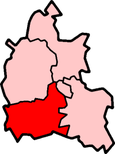Vale of White Horse
|
|
| Vale of White Horse District | |
|---|---|
 Shown within Oxfordshire | |
| Geography | |
| Status: | District |
| Region: | South East England |
| Admin. County: | Oxfordshire |
| Area: - Total | Ranked 83rd 578.63 km² |
| Admin. HQ: | Abingdon |
| ONS code: | 38UE |
| Demographics | |
| Population: - Total (2003 est.) - Density | Ranked 171st 115,981 200 / km² |
| Ethnicity: | 97.6% White |
| Politics | |
| Vale of White Horse District Council http://www.whitehorsedc.gov.uk/ | |
| Leadership: | Leader & Cabinet |
| Executive: | Liberal Democrats |
| MPs: | Evan Harris, Ed Vaizey |
The Vale of White Horse is a local government district of Oxfordshire in England. It is to the south of the county, and most of the area was previously part of Berkshire. The main town is Abingdon, other places include Faringdon and Wantage.
It takes its name from the Vale of the White Horse, a region lying between the Berkshire Downs and the River Thames, which in turn is named after the prehistoric Uffington White Horse.
DragonHill20040424_CopyrightKaihsuTai.jpg
It is the valley of the Ock, a stream which joins the Thames from the west at Abingdon. The vale is flat and well wooded, its green meadows and foliage contrasting richly with the bald summits of the White Horse Hills, which flank it on the south. On the north a lower ridge separates it from the upper Thames Valley; but local usage sometimes extends the vale to cover all the ground between the Cotswolds (on the north) and the White Horse Hills. According to the geographical definition, however, the vale is from 2 to 5 m. wide, and the distance by road from Abingdon to Shrivenham at its head is 18 m.
Wantage is the only town in the heart of the vale, lying in a sheltered hollow at the foot of the hills, along which, moreover, villages are more numerous than elsewhere in the vale. Towards the west, above Uffington, the hills reach a culminating point of 856ft in White Horse Hill. In its northern flank, just below the summit, a gigantic figure of a horse is cut, the turf being removed to show the white chalky soil beneath. This figure gives name to the hill, the range and the vale. It is 374ft long and of the rudest outline, the neck, body and tail varying little in width.
The origin of the figure is unknown, however tradition asserted it to be the monument of a victory over the Danes by King Alfred, who was born at Wantage; but the site of the battle, that of Ashdown (871), has been variously located. Moreover, the figure, with others of a similar character elsewhere in England, is considered to be of a far higher antiquity, dating even from before the Roman occupation. Many ancient remains occur in the vicinity of the Horse.
On the summit of the hill there is an extensive and well preserved circular camp, apparently used by the Romans, but of earlier origin. It is named Uffington Castle from the village in the vale below. Within a short distance are Hardwell Castle, a square work, and, on the southern slope of the hills near Ashdown Park, a small camp traditionally called Alfreds.
A smooth, steep gully on the north flank of White Horse Hill is called the Manger, and to the west of it rises a bald mound named Dragons Hill, the traditional scene of St George's victory over the dragon, the blood of which made the ground bare of grass for ever. But the name, properly Pendragon, is a Celtic form signiflying chief of kings, and may point to an early place of burial.
To the west of White Horse Hill lies a cromlech called Wayland Smiths Cave, said to be the home of a smith who was never seen, but shod the horses of travellers if they were left at the place with payment. The legend is elaborated, and the smith appears as a character, in Sir Walter Scott's novel Kenilworth. The White Horse itself has been carefully cleared of vegetation from time to time, and the process, known as the Scouring of the White Horse, was formerly made the occasion of a festival.
Sports of all kinds were held, and keen rivalry was maintained, not only between the inhabitants of the local villages, but between local champions and those from distant parts of England. The first of such festivals known took place in 1755, and they died out only subsequently to 1857. A grassy track represents the ancient road or ridge way along the crest of the hills continuing Icknield Street, from the Chilterns.
Hills to the north-east, across the Thames; and other earthworks in addition to those near the White Horse overlook the vale, such as Letcombe Castle above Wantage. At the foot of the hills not far east of the Horse is preserved the so-called Blowing Stone, a mass of sandstone pierced with holes in such a way that when blown like a trumpet a loud note is produced. It is believed that in the earliest times the stone served the purpose of a bugle.
Several of the village churches in the vale are of interest, notably the fine Early English cruciform building at Uffington. The length of the vale is traversed by the main line of the Great Western Railway, between Didcot and Swindon.
References
- Thomas Hughes, The Scouring of the White Horse (1859).

